Los Angeles
The days Los Angeles burned, the 1992 riots legacy 30 years later
“One of the most astounding things about the 1992 Los Angeles riots was the response of the LAPD, which is to say no response at all”

LOS ANGELES – It was a Wednesday, a verdict from the jury in Simi Valley in the case of four Los Angeles Police Department officers charged in the brutal beating of a Black man after a felony traffic stop the previous year was expected at any moment and tensions were running high in LA’s minority neighborhoods.
Rodney King, who was on parole for robbery, was beaten by LAPD officers during his arrest after a high-speed chase on March 3, 1991, for driving while intoxicated on the 210 freeway. When LAPD and California Highway Patrol cruisers finally stopped him, King was ordered out of the car.
What happened next was caught on video by a bystander as four LAPD officers then kicked him repeatedly and beat him with their batons for approximately 15 minutes. The video showed that more than a dozen other officers stood by, watching and some even were commenting on the beating.
King’s injuries resulted in skull fractures, broken bones and teeth, and permanent brain damage.
The graphic video of the attack was broadcast into homes in Southern California and then across the nation and worldwide provoking outrage and calls for the immediate removal of then LAPD Chief Darryl Gates.
Emotions ran so high that the trial of the four officers who were arrested on brutality and other criminal charges was ordered moved to Ventura County after a state appellate court panel ruled that political fallout and community anger was such that the officers could not get a fair hearing in Los Angeles because of “excessive publicity and a highly charged political climate,” the Los Angeles Times noted, and so the trial was moved. Simi Valley was more convenient geographically than Alameda County, a venue the prosecution preferred.
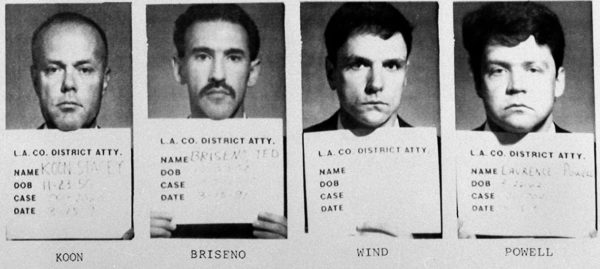
The trial got underway in early February of 1992 and in the last week of April the jury got the case. On April 29, 1992, a jury consisting of 12 residents from the distant suburbs of Ventura County — nine white, one Latino, one biracial, one Asian — found the four officers not guilty.
The acquittals were announced around 3 p.m. and less than three hours later, the unrest began.
A news helicopter piloted by Trans reporter-photo journalist Hanna Zoey Tur, who was then working for Los Angeles News Service/KCOP 13 TV, caught what arguably became the epic ground center in what would become a series of moving crowds of rioters spreading civil disturbances and massive property damage over the seven day period starting that afternoon on the 29th, lasting until May 4, 1992 when authorities ultimately regained control of both the City and County.
The civil unrest had commenced with gatherings of angered Angelenos especially Black residents not long after the verdict had been announced. But by 5:30 pm mobs had started to roam the streets of South Central LA with some limited property damage and vandalism. Then at around 6:46 pm, a truck entered the intersection at Florence and Normandie.
Tur and her Los Angeles News Service/KCOP 13 chopper crew caught what happened next and the live feed from the helicopter was broadcast to the nation and the world. A group of Black men who came to be known as the “L.A. Four” grabbed the 39-year-old truck driver, Reginald Oliver Denny and dragged him out of the truck.
Denny was beaten with fists, kicked, and struck with a cinder block, one man hurled a five-pound oxygenator at Denny’s head and the other kicked him and hit him with a claw hammer. While the beating continued Tur and her chopper continued to circle the scene Tur noting on air that there were virtually no LAPD units within sight of the attack.
After the beating ended, some men threw beer bottles at the unconscious body and a man searched Denny’s back pockets, taking his wallet. The attackers were chased off by locals who ran to assist the badly injured truck driver.
Denny suffered a fractured skull and impairment of his speech and his ability to walk, for which he underwent years of rehabilitative therapy.
The rioting spread to other sections of the city as residents set fires, looted and destroyed liquor stores, grocery stores, retail shops and fast food restaurants. Light-skinned motorists — both white and Latino — were targeted; some were pulled out of their cars and beaten.
There was more than the Rodney King case that exacerbated racial tensions in LA that Spring.
The same month as Rodney King’s beating the year before, a Korean store owner in South Los Angeles had shot and killed a 15-year-old African-American girl named Latasha Harlins, who was accused of trying to steal orange juice. It was later discovered Harlins was clutching money to pay for the juice when she was killed. The store owner received probation and a $500 fine, NPR reported in 2017.
The incident heightened tensions between Koreans and African-Americans, and intensified the black community’s frustration with the criminal justice system.
The other contributing factor was that the LAPD was seen by the city’s minority populations as little more than an army of occupation. In a 2017 in an interview with NPR’s Grigsby Bates, lawyer and civil rights activist Connie Rice said; “What we had was aggressive paramilitary policing with a culture that was mean and cruel, racist and abusive of force in communities of color, particularly poor communities of color.”
“It was an open campaign to suppress and contain the black community,” she added noting; “LAPD didn’t even feel it was necessary to distinguish between pruning out a suspected criminal where they had probable cause to stop and just stopping African-American judges and senators and prominent athletes and celebrities simply because they were driving nice cars.”
When 911 calls about the violence started coming in, LAPD units were not deployed immediately. In fact LAPD Chief Gates announced early in the afternoon of April 29 that his officers had the situation under control.
“One of the most astounding things about the 1992 Los Angeles riots was the response of the LAPD, which is to say no response at all,” says author Joe Domanick, who has studied and written about the riots, in an interview with NPR’s Grigsby Bates.
That night, Gates went to speak at a fundraiser in West Los Angeles and reportedly ordered cops to retreat. Police did not respond to incidents of looting and violence around the city until almost three hours after the original rioting broke out.
For the rest of the night, the scene at Florence and Normandie repeated itself with rioters across the city. Just before 9 p.m. that night, Mayor Tom Bradley called for a state of emergency, and California Gov. Pete Wilson ordered 2,000 National Guard troops to report to the city.
On May 1, the third day of the riots, Rodney King himself attempted to publicly appeal to Los Angeles residents to stop fighting. He stood outside a Beverly Hills courthouse with his lawyer and asked “People, I just want to say, you know, can we all get along? Can we get along?”
Ultimately there were 50 plus riot-related deaths including 10 people who were shot and killed by LAPD officers and National Guardsmen. More than 2,000 people were injured, and nearly 6,000 alleged looters and arsonists were arrested.
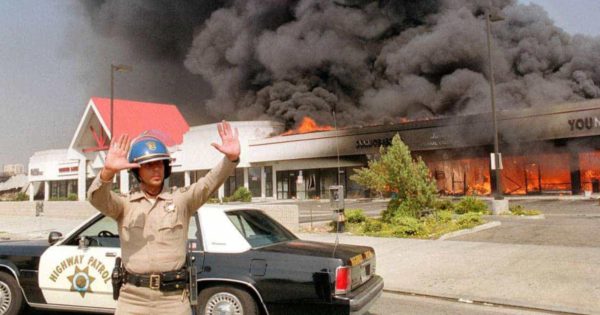
More than 1,000 buildings were damaged or destroyed, and approximately 2,000 Korean-run businesses were also damaged or destroyed. In all, approximately $1 billion worth of property was destroyed.
The Arlington, Virginia based think-tank the Rand Corporation found of those arrested during the riots, 36 percent were African-Americans and 51 percent were Latinos.
The Rodney King beating and the riots that came out of social issues that still have not been resolved as most recently evidenced by the Black Lives Matter movement propelled by ongoing killings of unarmed Black men by law enforcement agencies across the nation.
The relationship between the Black community and law enforcement remains frigid. According to a Los Angeles Times analysis, Black people make up less than 10 percent of the population in L.A. County, but 24 percent of law enforcement killings.
The economic disparities that concerned Black people in 1992 also persist today, including vast wealth inequality that affects multiple nonwhite groups. Remnants of the uprising still stand in the form of wrecked buildings never repaired.
The Los Angeles Times noted on Thursday that for all the strides that have been made since the 1992 L.A. riots, many Angelenos believe their city may still be a powder keg, according to a survey by the Thomas and Dorothy Leavey Center for the Study of Los Angeles at Loyola Marymount University.
The share of L.A. residents who expect that another wave of “riots and disturbances” will occur has hit the highest peak since the survey launched in 1997, with 68% saying it was either very or somewhat likely. Nearly 40% believe race relations in the city have worsened over the last four years.
Cecil Rhambo, the police chief at the Los Angeles International Airport, who is currently running to replace Los Angeles County Sheriff Alex Villanueva, in an interview with NBC News journalist Curtis Bunn said that some elements of Black life have improved over the last three decades, but not so much that an unpopular verdict involving a Black person and white law enforcement would not ignite another explosion of emotions onto the streets.
“There’s always a potential for riots or an uprising in the future,” he said. “Right now, inflation is running amok, largely in part due to what’s happening around the world that we can’t control. Covid hasn’t gone away. And so, I think there’s always an opportunity for things to get so bad that people repeat history.”
That history can be repeated, Rhambo said, because the potential for violence against Black people by law enforcement — with no one held accountable — remains strong.
“We just want to stop being mistreated by the police,” he said. “It’s just a basic common decency of how we treat people. That was the tipping point in 1992. If the George Floyd verdict had been different, I would not have been surprised if something happened. In the 1965 Watts riots and in ’92, it was the perfect storm that led to the violence. We have a perfect storm going on now that creates this powder keg. So there’s always a potential for that in the future.”
27 Photos of the Horrific 1992 Los Angeles Riots:
*********************
Additional reporting from NPR, The Los Angeles Times, and NBC News Los Angeles
Los Angeles
Recent L.A. County report reveals record number of hate crimes against transgender and nonbinary community members
The county’s Commission on Human Relations (LACCHR) released its annual hate crime analysis, revealing a rising violence against LGBTQ+ Angelinos.
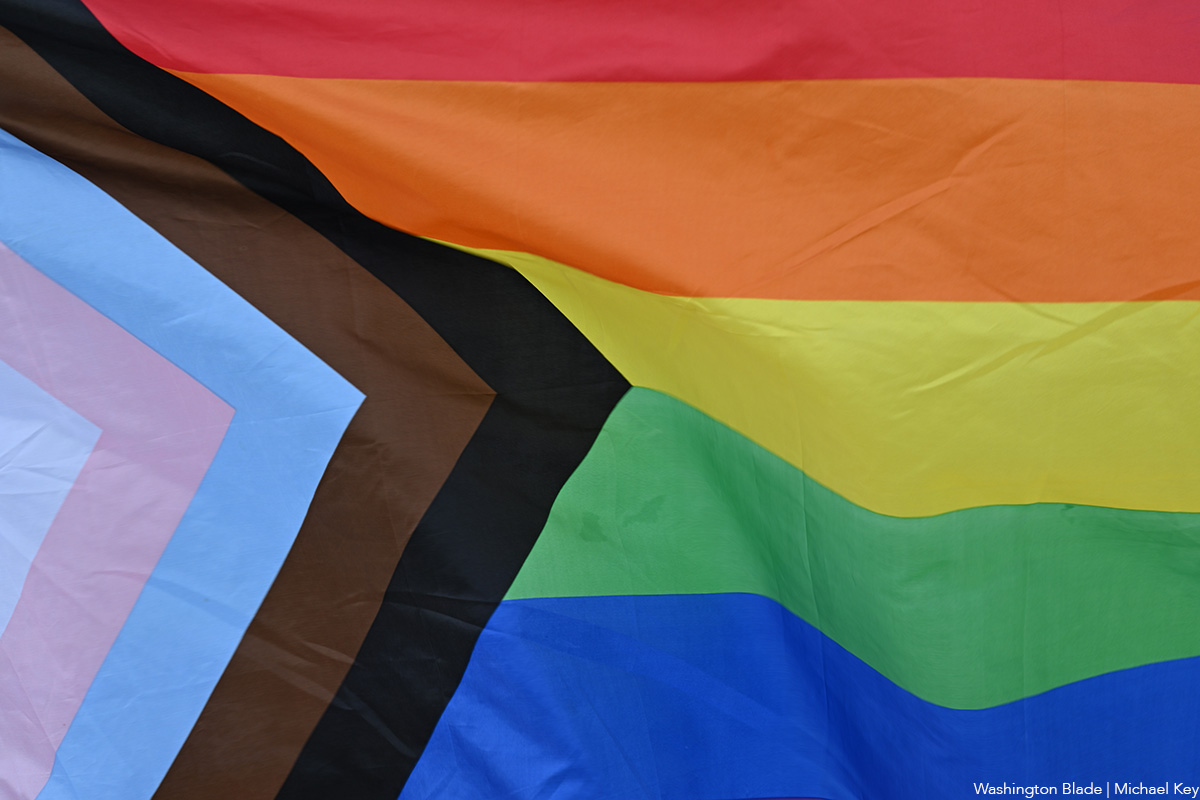
Last Thursday, Los Angeles County’s Commission on Human Relations (LACCHR) released its 2024 Hate Crime Report, which analyzes data compiled from over 100 reporting groups, including local law enforcement agencies, educational institutions, and community-based organizations like the TransLatin@ Coalition. In its 45-year history of compiling these reports, the LACCHR recorded an “unprecedented” amount of hate crimes in this most recent analysis.
The report states that there were 102 anti-transgender crimes, “the largest number ever documented in this report.” 95% of these reported incidents were violent.
Part of the reason for this increase in reported crimes is the expanding outreach LACCHR is trying to create with partner organizations, ensuring that queer community members feel increasingly safe in reporting crimes that have been committed against them. These “grassroots efforts” have proven invaluable in building community trust, according to Dr. Monica Lomeli, who leads the production of LACCHR’s annual hate crime report.
“For the LGBTQ community, [there’s] a history of not being heard, not being believed or being misgendered,” Lomeli told the Blade. “I remember us working with a lot of different law enforcement agencies [and] victims would tell us: ‘They keep misgendering me. They don’t believe me. They keep having me make different reports.”
Lomeli stresses that, for those who feel unsafe reporting hate crimes to law enforcement agents, there are other options. One of these pathways is the commission’s community-centered initiative and reporting system, LA vs Hate, which allows people to report hate crimes and access resources like multilingual reporting guides. There is also 211 LA, a program funded by the commission that provides free, confidential support in 140 languages.
The report is instrumental to the formation of initiatives focused on queer safety and is also a resource to various LGBTQ+ organizations as they track violence committed against their community members. But the collection of this data has not been smooth, especially in this current administration.
Lomeli explained that, earlier this year, the now-defunct Department of Government Efficiency (DOGE) reached out to various human rights organizations, including the LACCHR, and was aiming to gain access to and shut down the commission’s hate crime database. “There was an attempt to bring down our data,” said Lomeli, who described these attempts as an infringement on the general public’s ability to access the report’s findings.
Moving forward, the commission’s Network Against Hate Crime, which hosts quarterly meetings with leaders from law enforcement agencies, advocacy groups, educational institutions, and social services providers, will hold a briefing on the report and discuss collaborative solutions to support community members.
Lomeli hopes to bring LGBTQ+ issues to the “forefront” of one of these upcoming meetings, given the high number of hate crimes committed against queer community members that were highlighted in the report. LA vs Hate will also continue to host campaigns, marketing efforts, and awareness events to promote the equitable treatment and safe existence of queer and other marginalized Angelinos.
Los Angeles
LGBTQ+ community calls out Radio Korea over host’s homophobic comments; station acknowledges but skirts accountability
On Nov. 3rd, Radio Korea host Julie An claimed that “gay people began the spread of AIDS” on a talk show broadcast by the station.
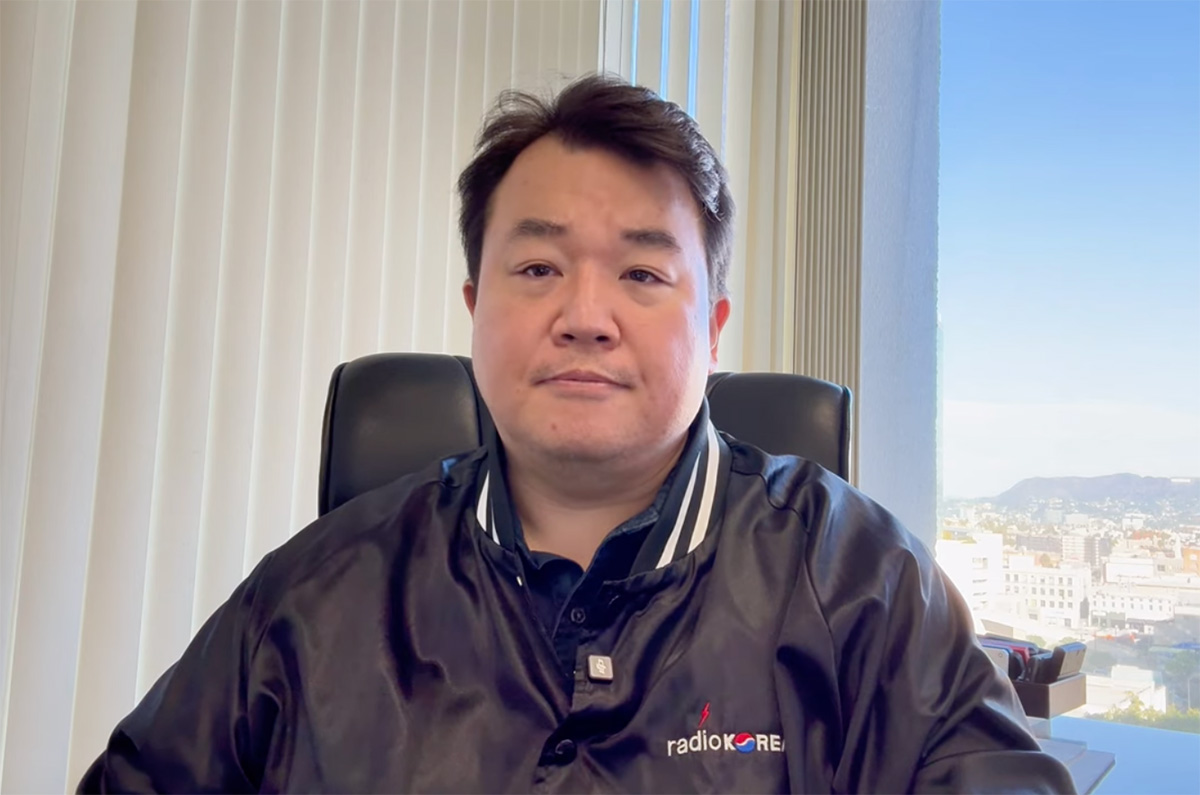
On Monday, Nov. 3rd, Radio Korea aired its regular morning talk show program, where one of its hosts, Julie An, discussed her lack of support for the LGBTQ+ community, citing her religious beliefs. She also went on to comment that gay people spread HIV and AIDS, and that conversation therapy — which has been linked to PTSD, suicidality, and depression — is a viable practice. Clips of this have since been taken down.
Radio Korea offers Korean language programming to engage local Korean American and Korean immigrant community members. Its reach is broad, as Los Angeles is home to the largest Korean population in the U.S, with over 300,000 residents. As An’s words echoed through the station’s airwaves, queer Korean community members took to social media to voice their concern, hurt, and anger.
In a now-deleted Instagram post, attorney, activist, and former congressional candidate David Yung Ho Kim demanded accountability from the station. Writer and entertainer Nathan Ramos-Park made videos calling out Radio Korea and An, stating that her comments “embolden” people with misinformation, which has the ability to perpetuate “violence against queer people.”
Community health professional Gavin Kwon also worries about how comments like An’s increase stigma within the Korean immigrant community, which could lead to increased discrimination against queer people and their willingness to seek health care.
Kwon, who works at a local clinic in Koreatown, told the Blade that comments like An’s prescribe being gay or queer as a “moral failure,” and that this commonly-held belief within the Korean immigrant community, particularly in older generations, strengthens the reticence and avoidance clients hold onto when asked about their gender or sexual orientation.
“When you stigmatize a group, people don’t avoid the disease — they avoid care,” Kwon explained. “They avoid getting tested, avoid disclosing their status, and avoid talking openly with providers. Stigma pushes people into silence, and silence is the worst possible environment for managing any infectious disease.”
For weeks, Radio Korea did not offer a direct response to the public criticism. Its Instagram feed continued to be updated with shorts, featuring clips of its various hosts — including An.
On Friday, Radio Korea CEO Michael Kim released an official statement on the station’s YouTube page. In this video, Kim stated that An’s comments “included factual inaccuracies” and that the station “does not endorse or share the personal opinions expressed by individual hosts.” Kim also stated that Radio Korea “welcomes members of the LGBT community to share their perspectives” in order to deepen understanding through dialogue.
Afterwards, Kim continued that though he acknowledges the “pain” felt by queer community members, he concluded: “I don’t think Radio Korea needs to apologize for what was said any more than Netflix should apologize for what Dave Chappelle says, or any more than Instagram or TikTok should apologize for what people say on their platforms.”
Kim then offered a justification that An’s statements were “not part of a news report,” and that he was “disappointed” that David Yung Ho Kim, specifically, had been vocal about An’s comments. Kim stated that he was the first person to interview David in 2020 during his congressional campaign, and that he had provided the candidate a platform and opportunity to educate listeners about politics.
“After all these years, the support Radio Korea has given him,” said Kim, “the support I personally gave him, even the support from other Radio Korea members who donated or even volunteered for him — he dishonestly tried to portray Radio Korea as being an anti-gay organization.”
Kim went on to criticize David’s purported “hurry to condemn others,” and also questioned if David has disowned his father, who he states is a pastor. “What kind of person is David Kim, and is this the kind of person we want in Congress?” Kim asked viewers, noting that Koreatown is “only about three miles from Hollywood, and some people just like to perform.”
At the end of the video, Kim stated that his duty is to guard the legacy of the station. “My responsibility is to protect what was built before me and ensure that Radio Korea continues serving this community long after today’s momentary controversies disappear,” Kim said.
For community members and advocates, this response was unsatisfactory. “The overall tone of the statement felt more defensive than accountable,” Kwon wrote to the Blade. “Instead of a sincere apology to the LGBTQ+ community that was harmed, the message shifts into personal grievances, political dynamics, and side explanations that don’t belong in an official response.”
Kim’s portrayal of the criticism and calls to action by community members as a “momentary controversy” paints a clearer picture of the station’s stance — that the hurt felt and expressed by its queer community members is something that will simply pass until it is forgotten. An continues to be platformed at Radio Korea, and was posted on the station’s social media channels as recently as yesterday. The station has not outlined any other action since Kim’s statement.
Kristie Song is a California Local News Fellow placed with the Los Angeles Blade. The California Local News Fellowship is a state-funded initiative to support and strengthen local news reporting. Learn more about it at fellowships.journalism.berkeley.edu/cafellows.
Los Angeles
Forgetting queer pioneer Morris Kight is “impossible”: Advocates and friends share stories at remembrance
On Saturday, Nov. 22nd, Kight’s ashes were interred at Hollywood Forever Cemetery.
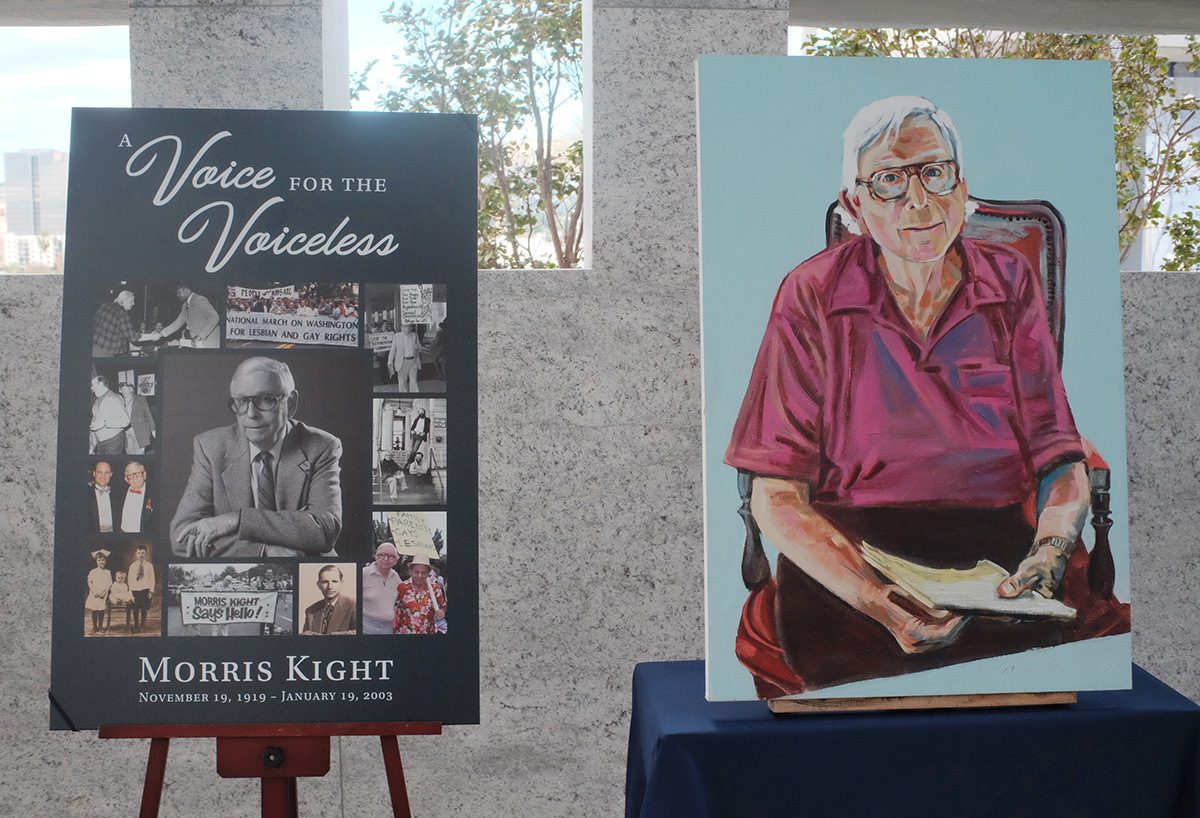
Over 50 people made their way to the rooftop chapel at Hollywood Forever Cemetery’s Gower Mausoleum on Saturday afternoon, taking in sweeping views of the city as a gentle wind began to envelop the space — a wind that some thought signaled the presence of Morris Kight. Hosted by local nonprofit AIDS Healthcare Foundation (AHF), this reception provided longtime friends, fellow activists, and anyone else impacted by Kight’s legacy with the opportunity to share some of their most memorable stories about the LGBTQ+ vanguard.

Kight died on January 19, 2003, after decades of leading peaceful, bold, and outspoken action against oppressive systems that targeted marginalized communities. As Congresswoman Maxine Waters declared at the remembrance event: “You have to be a hell of somebody to be memorialized 22 years after.”
Kight co-founded the Los Angeles LGBT Center in 1969, first known as the Gay Community Services Center, where so many queer youth and adults found the courage and empowerment to seek education, resources, and comfort. It became the place where they could fully embrace themselves.
At 19, AHF president Michael Weinstein found himself at the front steps of the Center, afraid but compelled. This is where his and Kight’s lives would intertwine, setting him on his own path of liberatory leadership. This first encounter and relationship “cemented” his identity, Weinstein told the crowd, after an arduous search for belonging and internal understanding.
The impact Kight had on Weinstein and innumerable other queer folks was not just a consequence of his work, but the purpose for it all. “We were his payment. We were his reward,” said Miki Jackson, Kight’s longtime friend and another instrumental voice in early LGBTQ+ movements. “Morris cared that we were loud enough, we were out enough, we were visible enough that a child in Kansas in elementary school would know about it. He cared about where people were wounded the most.”
Kight projected his voice in hopes it would reach those who were silenced, becoming the face of several important movements, including the Gay Liberation Front. He raised money for people with AIDS, co-founded the Stonewall Democratic Club, and pushed for L.A.’s first pride parade in 1970 — unabashedly fighting for the visibility of LGBTQ+ people as they were met with societal violence and rejection.

“The idea of forgetting a Morris Kight is basically impossible,” said Terry DeCrescenzo, one of the founders of the Gay Academic Union. She recounted fond memories with Kight, including a story tied with her roots of protesting. Together, they blocked the streets of Sunset and Larrabee and sang the civil rights anthem “We shall overcome.” At first, DeCrescenzo was in disbelief. “I thought, ‘I went to Catholic school for 17 years to sit on the sidewalk singing We shall overcome?’ And the answer is yes. He showed me a way of doing things — of approaching life — that I didn’t dream I was capable of. So I thank you, Morris. I love you. I miss you.”
Kight’s ashes have been officially interred at Hollywood Forever Cemetery, granting him a final resting place. In life, he built sites of belonging for queer people, and today, this ground joins a tender catalog of spaces that contains a trace of what his loved ones hope he is remembered for: the fierce kindness with which he led his life. His endless stories. His desire to be with and fight for the people he loved.
Saturday’s remembrance event also offered a moment of deep reflection for the future of local queer activism. “We’re what we have left,” said Jackson, a queer elder who marched alongside Kight in the country’s early days of LGBTQ+ protesting — and who paved a path for younger advocates like Congressman and Equality Caucus Chair Mark Takano to continue the fight. “May we honor Morris by carrying his fire forward until every LGBTQ+ person in this country can live safely, open and unafraid,” said Takano.
Kristie Song is a California Local News Fellow placed with the Los Angeles Blade. The California Local News Fellowship is a state-funded initiative to support and strengthen local news reporting. Learn more about it at fellowships.journalism.berkeley.edu/cafellows.
Los Angeles
The Los Angeles LGBT Center has reopened and upgraded its community tech hub
The David Bohnett CyberCenter provides free access to important tech resources for LGBTQ+ community members.
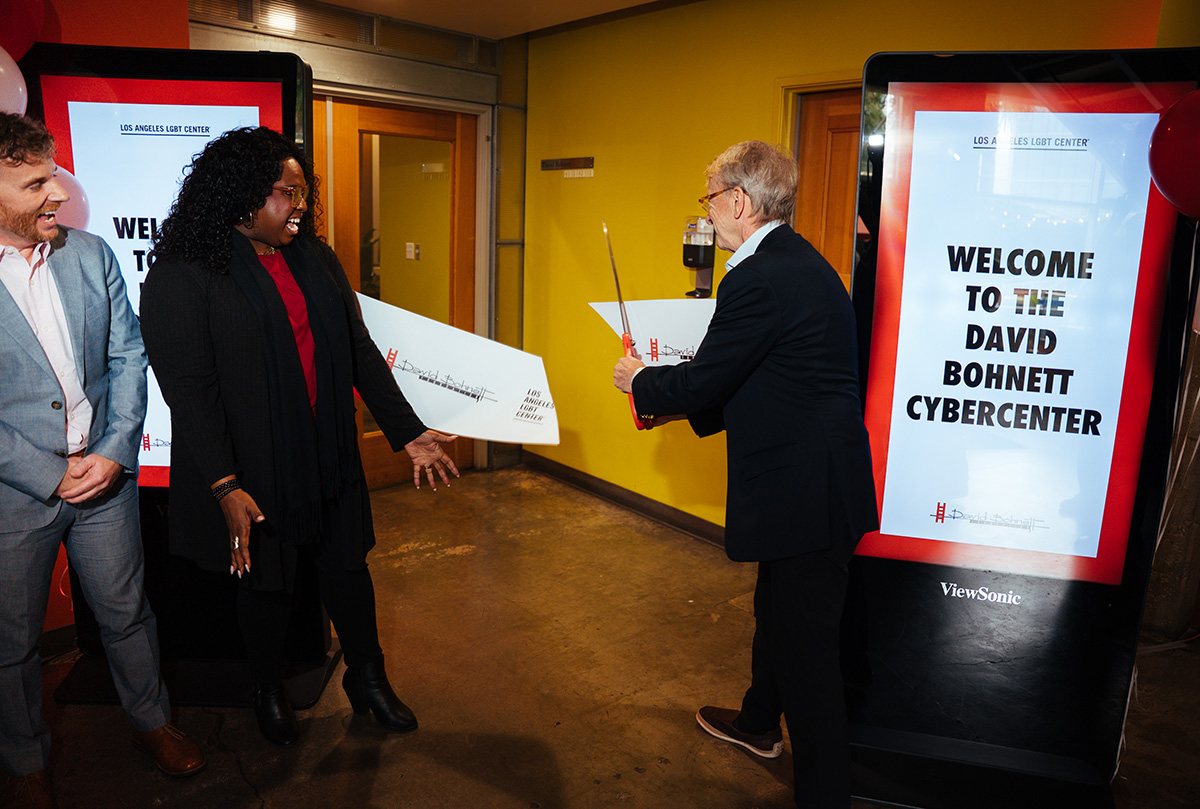
On Thursday, community leaders and advocates gathered at the Los Angeles LGBT Center for a joyous ribbon-cutting event that ushered in the organization’s revamped tech hub. For 27 years, the organization’s David Bohnett CyberCenter has provided local residents a safe space to utilize computers, printers, scanners, and attend workshop opportunities to build their tech literacy skills, stay connected, discover joy, and research important opportunities.
Here, individuals can safely surf the web, complete online benefits and services forms, apply for jobs, as well as make progress towards educational programs. It’s a safe space where LGBTQ+ community members can reliably use technology that can provide them with vital avenues into improving and living their lives.
The CyberCenter is funded by the David Bohnett Foundation, which provides grants to various LGBTQ+ initiatives and social programs nationally in order to improve equity for different marginalized communities. In 1998, the foundation established its first tech hub at the Los Angeles LGBT Center, so that queer community members would not be shut away as technological advancements made online access increasingly necessary. “The idea was simple but urgent,” Bohnett said at yesterday’s ceremony. “[It was meant] to ensure that LGBTQ+ people had access to the technology that could open doors to education, employment, and connection.”
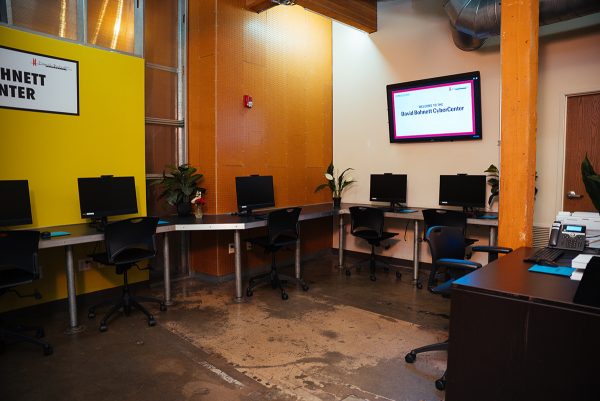
Yesterday, this CyberCenter’s updated facilities were welcomed with warm applause, cheer, and a celebratory banner that was cut by Bohnett himself. It marked an evolving growth towards the foundation and the Center’s shared commitment to the hub’s initial promise: to guarantee equitable technological access to the county’s queer residents.
“Our community members regularly share how missing even one piece of access—a computer, a quiet place to work, a stable connection—can stall their progress,” said Sydney Rogers, senior program manager at the Trans Wellness Center. “For so many, technology isn’t just a tool—it’s the gateway to opportunity. Résumés, job searches, online trainings, interview prep—all of it depends on having access to reliable equipment and an environment where people feel safe and supported.”
For Bohnett, what began as a room with a “handful of computers” has grown into over 60 CyberCenters nationwide — and they are all “rooted in the belief that digital access is not a luxury, but a lifeline,” said Bohnett. “Every time I’m back here, I’m reminded that the Los Angeles LGBT Center was the first to bring that vision to life.”
The David Bohnett CyberCenter is open from Tuesdays to Thursdays, from 10 a.m. to 1 p.m., and from 2-5 p.m. More information about its location and services can be found here.
Los Angeles
This queer, Latine-led organization is protecting residents against SNAP cuts and immigration raids
The weeks-long delay in SNAP benefits left food insecure residents stranded. Community centers like Mi Centro worked to help them.

Light rain and mist loomed over the quiet Boyle Heights Neighborhood on Friday morning as residents made their way towards a free farmer’s market at Mi Centro, a community center on South Clarence Street. There, they were greeted with a warm“buenos días” by program coordinator Norma Sánchez and guided into an adjacent room with crates of fresh produce and a table with mental health resources.
Created in collaboration with team members from both the Los Angeles LGBT Center and the Latino Equality Alliance, Mi Centro doubles as a hub for information and resources as well as a sanctuary of respite and comfort for its Latine community members. It provides immigration services, legal clinics, housing rights panels, and a monthly free farmers’ market. This November, Mi Centro has organized an additional market with the support of collaborating organizations, including food justice ministry Seeds of Hope, to step up for community members after SNAP benefits were cut at the beginning of the month.
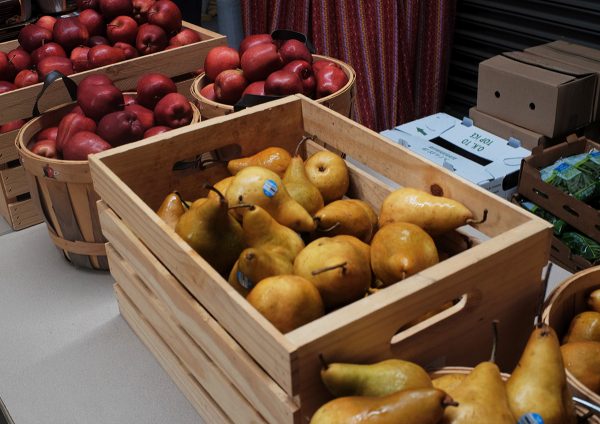
Combined with the increased presence of federal immigration agents in the county since June, this cut in essential funding has created additional strain for local Latine community members when it comes to accessing food and feeling safe when stepping outside. For staff members at Mi Centro, these issues impact the livelihoods and safety of the people and spaces most familiar and important to them. “This is the community where my family immigrated to,” Caín Andrade, Mi Centro’s program manager, told the Blade. “Now I feel like it’s not only my duty, but my pleasure and my privilege to come back to the same community and help.”
At Friday’s market, Andrade noted that it yielded one of the “biggest turnouts” despite the weather, and explained that Mi Centro has seen a steady increase in the need for food and resource assistance in the last couple of months. Several community members showed up to access groceries and look through the other resource tables at the market. One of these tables included information about benefits and insurance enrollment, and another included pamphlets from local health nonprofit QueensCare about free health screenings. All written materials were provided in both Spanish and English, and Sánchez made sure to speak with each resident about their needs.
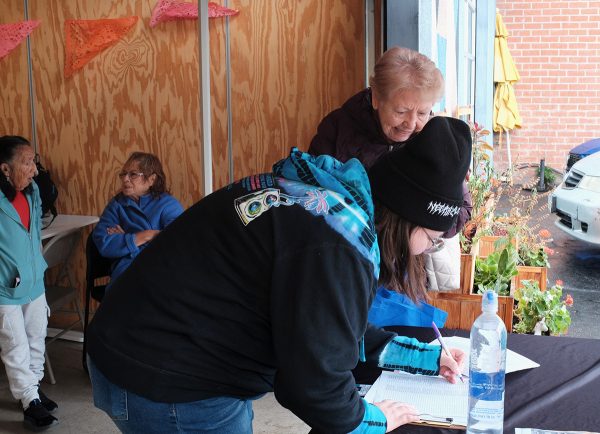
“We really curated Mi Centro as a community center where people can feel like they belong,” said Andrade. “[We] provide a space that feels a little bit more like home to them: that’s warm, that’s got flowers and art, a couch to sit on, and just have somebody that listens to you — somebody that can speak Spanish and give them the opportunity to articulate what they’re going through in their language. We can see the sighs of relief.”
Andrade also emphasizes the intergenerational teamwork that happens at Mi Centro: a synergy that is guided by “young, queer Latino community” voices that have been embedded within the neighborhood. Mi Centro’s queer staff are deeply shaped by these communities that have long been home to them — and they, in turn, are shaping these spaces to be more inclusive: where LGBTQ+ visibility is embraced and cherished.
With a team that “represents the entire rainbow,” residents see the advocates working to support them as “our kids, our nephews, our grandkids,” Andrade said. “We are equally protective of them. We want to make sure that they are being given access to everything that other communities might have easy access to.”
Mi Centro’s next free farmer’s market takes place on Friday, Nov. 21st. More information can be found here.
Los Angeles
LA Assessor Jeffrey Prang to be honored by Stonewall Democrats
Prang is among America’s longest-serving openly gay elected officials
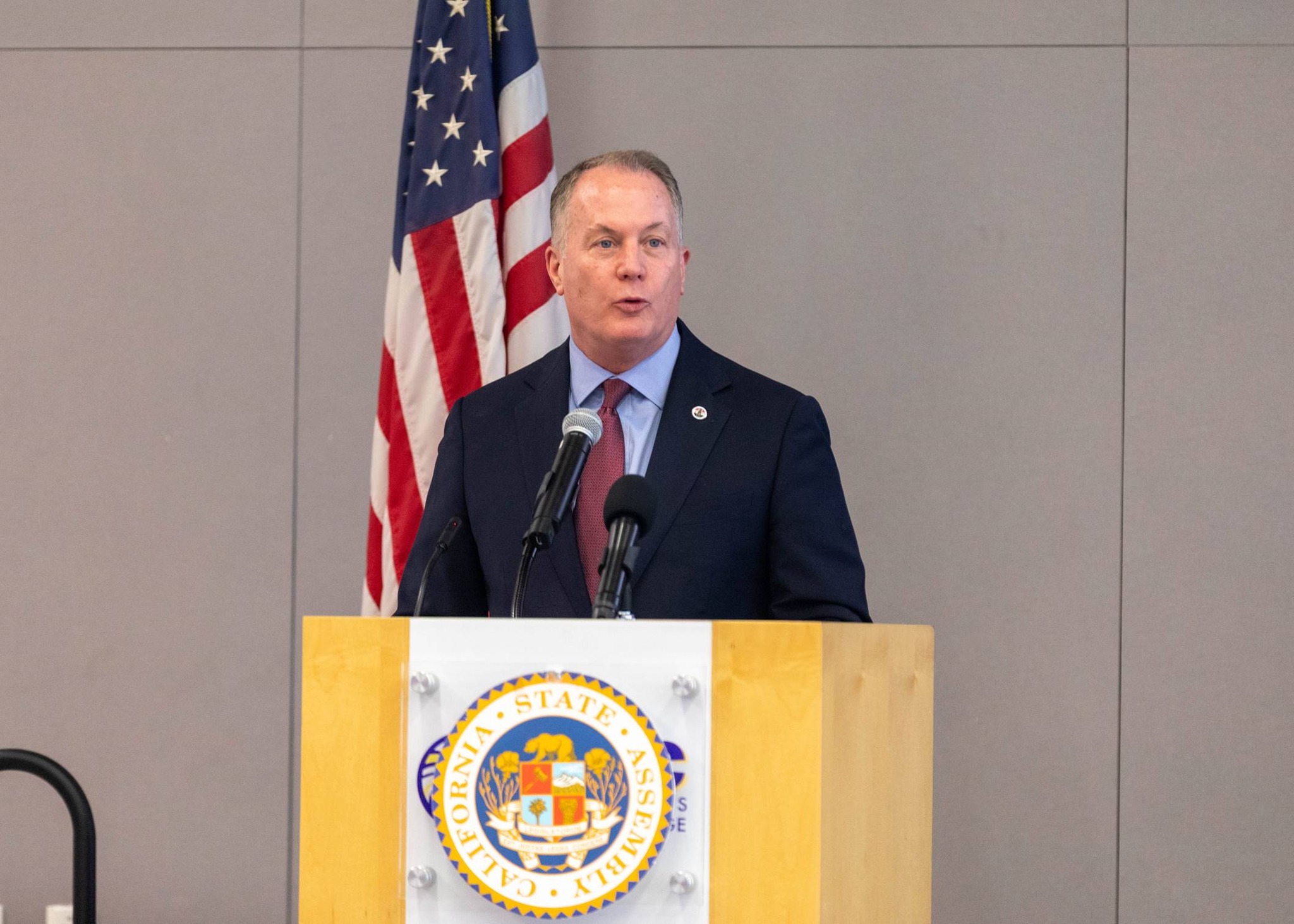
You may not be too familiar with LA County Assessor Jeffrey Prang. You’ve probably never heard of the office of the LA County Assessor, or you might only have a vague notion of what it does.
But with a career in city politics spanning nearly thirty years, he’s among the longest-serving openly gay elected officials in the United States, and for his work serving the people of Los Angeles and championing the rights of the city’s LGBTQ people, the Stonewall Democratic Club is honoring him at their 50th Anniversary Celebration and Awards Night Nov 15 at Beaches Tropicana in West Hollywood.
Prang moved to Los Angeles from his native Michigan after college in 1991, specifically seeking an opportunity to serve in politics as an openly gay man. In 1997, he was elected to the West Hollywood City Council, where he served for 18 years, including four stints as mayor.
“I was active in politics, but in Michigan at the time I left, you couldn’t really be out and involved in politics… My life was so compartmentalized. I had my straight friends, my gay friends, my political friends, and I couldn’t really mix and match those things,” he says.
“One of the things that was really impactful was as you drove down Santa Monica Boulevard and saw those rainbow flags placed there by the government in the median island. That really said, this is a place where you can be yourself. You don’t have to be afraid.”
One thing that’s changed over Prang’s time in office is West Hollywood’s uniqueness as a place of safety for the queer community.
“It used to be, you could only be out and gay and politically involved if you were from Silver Lake or from West Hollywood. The thought of being able to do that in Downey or Monterey Park or Pomona was foreign. But now we have LGBTQ centers, gay pride celebrations, and LGBT elected officials in all those jurisdictions, something that we wouldn’t have thought possible 40 years ago,” he says.
Prang’s jump to county politics is emblematic of that shift. In 2014, amid a scandal that brought down the previous county assessor, Prang threw his name in contention for the job, having worked in the assessor’s office already for the previous two years. He beat out eleven contenders in the election, won reelection in 2018 and 2022, and is seeking a fourth term next year.
To put those victories in perspective, at the time of his first election, Prang represented more people than any other openly gay elected official in the world.
Beyond his office, Prang has lent his experience with ballot box success to helping get more LGBT people elected through his work with the Stonewall Democrats and with a new organization he co-founded last year called the LA County LGBTQ Elected Officials Association (LACLEO).
LACLEO counts more than fifty members, including officials from all parts of the county, municipal and state legislators, and members of school boards, water boards, and city clerks.
“I assembled this group to collectively use our elected strength and influence to help impact policy in Sacramento and in Washington, DC, to take advantage of these elected leaders who have a bigger voice in government than the average person, and to train them and educate them to be better advocates on behalf of the issues that are important for us,” Prang says.
“I do believe as a senior high-level official I need to play a role and have an important voice in supporting our community,” he says.
Ok, but what is the LA County assessor, anyway?
“Nobody knows what the assessor is. 99% of people think I’m the guy who collects taxes,” Prang says.
The assessor makes sure that all properties in the county are properly recorded and fairly assessed so that taxes can be levied correctly. It’s a wonky job, but one that has a big impact on how the city raises money for programs.
And that wonkiness suits Prang just fine. While the job may seem unglamorous, he gleefully boasts about his work overhauling the office’s technology to improve customer service and efficiency, which he says is proving to be a role model for other county offices.
“I inherited this 1970s-era mainframe green screen DOS-based legacy system. And believe it or not, that’s the standard technology for most large government agencies. That’s why the DMV sucks. That’s why the tax collection system sucks. But I spent $130 million over almost 10 years to rebuild our system to a digitized cloud-based system,” Prang says.
“I think the fact that my program was so successful did give some impetus to the board funding the tax collector and the auditor-controller to update their system, which is 40 years behind where they need to be.”
More tangible impacts for everyday Angelenos include his outreach to promote tax savings programs for homeowners, seniors, and nonprofits, and a new college training program that gives students a pipeline to good jobs in the county.
As attacks on the queer community intensify from the federal government, Prang says the Stonewall Democrats are an important locus of organization and resistance, and he encourages anyone to get involved.
“It is still an important and relevant organization that provides opportunities for LGBTQ people to get involved, to have an impact on our government and our civic life. If you just wanna come and volunteer and donate your time, it provides that, if you really want to do more and have a bigger voice and move into areas of leadership, it provides an opportunity for that as well,” he says.
Los Angeles
SNAP benefits remain delayed — local leaders are creating their own solutions
Assemblymember Mark González has announced a $7.5 million partnership with the YMCA’s FeedLA food distribution program.
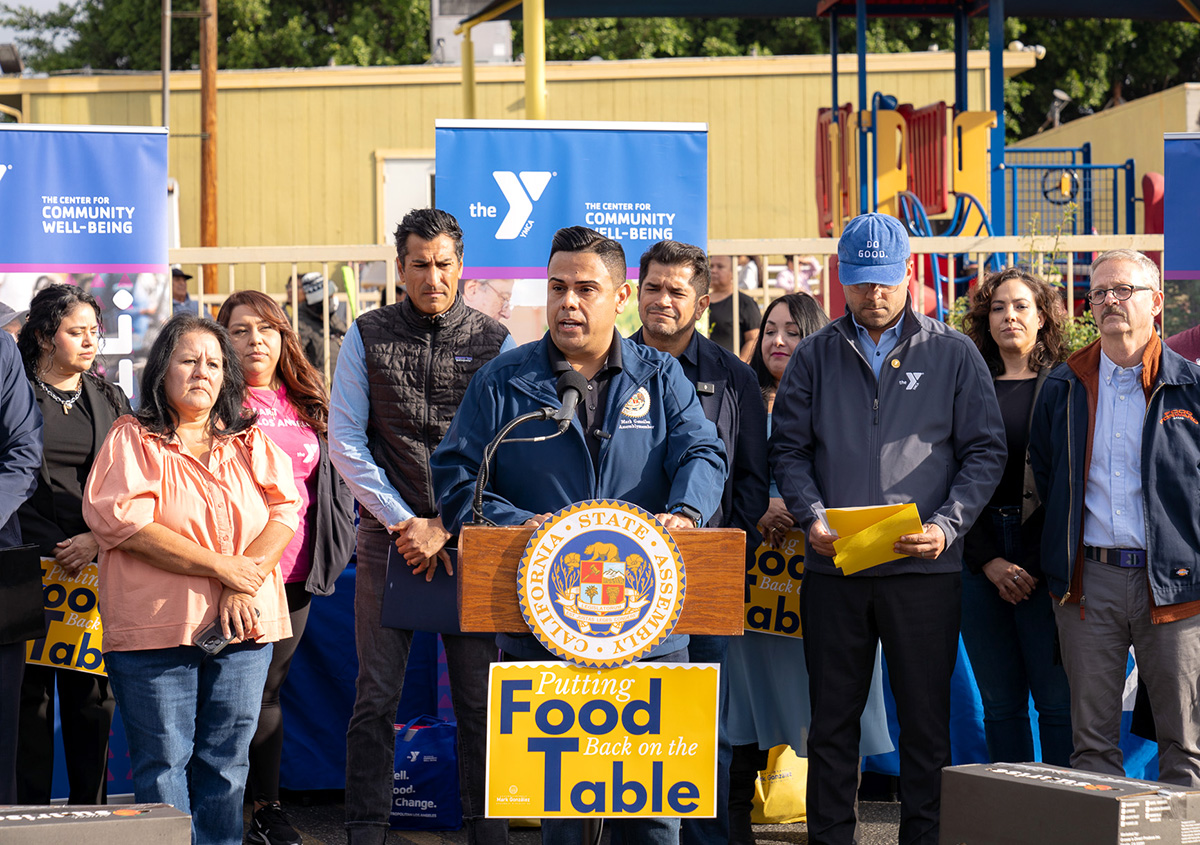
Today marks the 37th day of the current government shutdown, the longest witnessed in the country’s history. As a result, people who receive federal Supplemental Nutrition Assistance Program (SNAP) benefits have not received their monthly aid for November. In Los Angeles, over 1.5 million people rely on these funds to purchase groceries.
On Oct. 28th, Governor Gavin Newsom announced that California joined over 20 other states in suing the administration over its “unlawful refusal” to provide SNAP aid even though it has the funds to do so. Two federal judges ruled in favor of the lawsuit, though when and how much aid will be distributed remains inconclusive.
At a press briefing on Tuesday, White House press secretary Karoline Leavitt stated that the administration is “fully complying” with the court order. “The recipients of the SNAP benefits need to understand: it’s going to take some time to receive this money because the Democrats have forced the administration into a very untenable position,” Leavitt continued. “We are digging into a contingency fund that is supposed to be for emergencies, catastrophes, for war.”
On Wednesday morning, local leaders in Los Angeles held their own press conference at the Weingart East Los Angeles YMCA to denounce the administration’s inaction and to discuss alternative efforts that are trying to fill the gap as SNAP aid remains suspended. “We’re here today because the federal government has turned its back on millions of families, and we refuse to stay silent,” said District 54 Assemblymember Mark González. “This is more than a press conference. This is a plea for sanity, a demand for humanity, and a call to action…California is stepping up to do what Washington will not, and that’s to feed our people.”
Alongside a number of other local leaders and advocates, including Assemblymember Jesse Gabriel, Speaker of the California State Assembly Robert Rivas, Boyle Heights community leader Margarita “Mago” Amador, Congressman Jimmy Gomez, YMCA president Victor Dominguez, and Food Forward founder Rick Nahmias, González announced a partnership with the YMCA’s FeedLA program. $7.5 million has been secured to fund food distribution efforts across the county’s 29 YMCA sites.
Residents do not need to have a YMCA membership to take part. Resources like groceries, warm meals, and home deliveries will be available at various times throughout the week. There are currently no weekend distribution dates listed.
This announcement comes in the midst of other local efforts bolstering on-the-ground SNAP relief. On Tuesday, the Los Angeles County Board of Supervisors approved a motion that will strengthen the Office of Food Systems (OFS), a partnership between county leaders and local philanthropic organizations aiming to create equitable food systems for residents. The motion would establish deeper connections between OFS and all County departments, as well as strengthen state and federal food policy coordination.
The county has also funded a $10 million contract with the Los Angeles Regional Food Bank, which will allow the organization to purchase more produce and create additional pantry and food distribution pop-up sites.
For many, these solutions offer a temporary landing pad as they hold out for their benefits to be reinstated. “Food pantries are not just places where a bag of food is handed out. They are a bridge of hope for our most vulnerable communities,” said Amador, at Wednesday’s press conference. “When a family comes to a pantry, many times they don’t just bring an empty bag. They also bring worries, stress and [the] fear of not being able to feed their children. They leave with a bag of food [and] they take with them a bit of dignity, relief, and a feeling that they are not alone.”
Los Angeles
Queer communities will face disproportionate harm when SNAP ends
The Blade spoke with researchers, local leaders and food distribution organizers to discuss the impact on LGBTQ+ people

On Oct. 1st, the previous federal budget expired, and the government entered a shutdown after being unable to reach an agreement on how different government services would be funded moving forward. Namely, democratic officials are arguing for more affordable healthcare as well as a reversal of President Trump’s cuts to Medicaid and health agencies, as proposed in H.R. 1 — otherwise known as the “One Big Beautiful Bill Act.” Without a compromise that Trump will agree to, several essential federal services remain stalled.
Now, the federal Supplemental Nutrition Assistance Program (SNAP), formerly known as food stamps, will be indefinitely halted beginning Nov. 1st. This affects over 1.5 million Los Angeles residents who rely on CalFresh, the state’s equivalent of SNAP. BenefitsCal, the portal Californians can use to access and manage benefits that include food assistance, announced on Oct. 27th that “the U.S. Department of Agriculture (U.S.D.A.) is not sending money to states for November CalFresh (SNAP) benefits. This means your county cannot add money to your EBT card until federal funding is restored.”
For LGBTQ+ community members, this impact will be particularly damaging.
Over 665,000 LGBTQ+ adults live in Los Angeles County, and 32% of this population reported experiencing food insecurity from 2023 to 2024, according to data analysis completed by researchers at the Williams Institute. In comparison, 23% of non-LGBTQ+ adults reported experiencing food insecurity.
“I think it’s important to realize that many people who are on SNAP are either disabled and can’t work, or they’re caretaking for young children — and those tend to be the groups of people in the LGBTQ community,” Brad Sears, the Rand Schrader Distinguished Scholar of Law and Policy at the Williams Institute, told the Blade. “Over 60% of LGBTQ people on SNAP are disabled, and about 46% are raising children…There aren’t a lot of options for them in meeting their basic needs, [like] providing food for themselves and their families, besides SNAP benefits.”
How can LGBTQ+ community members access food assistance in November?
Sears pointed out how, in times of social struggle, queer communities have turned to each other for support. He states that it is important, now more than ever, for local organizations and food distribution programs to stand in solidarity with LGBTQ+ people — many of whom face barriers to seeking resources due to various factors like the fear of discrimination. “This is an important time to send that message that they are inclusive, that their services are inclusive, and that everyone, including LGBTQ people, are welcome to access their resources,” Sears told the Blade.
The Hollywood Food Coalition is one of these spaces. The organization rescues and redistributes food through a community exchange program, and also provides hundreds of dinners to community members every day of the year. “We are open to anyone hungry. We’re proud to serve many LGBTQ+ guests and to offer a welcoming space where everyone can share a meal and feel safe, seen, and cared for,” Linda Pianigiani, the organization’s interim director of development, told the Blade.
The Los Angeles LGBT Center is also partnering with food justice organization Seeds of Hope to provide more free farmers’ markets this upcoming month. For Giovanna Fischer, the Center’s chief equity officer, this is an opportunity to champion intersectional queer empowerment in the midst of the administration’s actions. For marginalized community members, including those who are trans, disabled, or immigrants, organizers are thinking about multidimensional approaches as they support community members through crises like the indefinite end to SNAP benefits.
“Now we’re looking at an issue [that can be] compounded three times simply because of who that person is and the experience that they have in their life,” Fischer told the Blade. “There’s no single-issue analysis of anything that’s coming up for our community, because we’re not living single-issue lives…How are we thinking through things in a layered way to ensure that people with these intersectional identities have access to the things that they need?”
How is the state and county responding?
On Tuesday, Governor Newsom announced that California is joining 20 other states in suing the administration for its “unlawful refusal” to continue funding SNAP. Los Angeles County Supervisor Lindsey Horvath also stated in a press release that the county is working to fund a $10 million contract with the Los Angeles Regional Food Bank to expand food purchasing capabilities and create more food assistance pop-up sites and community pantry locations.
L.A. Care Health Plan is also investing up to $5.4 million to fund countywide food security and distribution efforts, as well as provide aid to nonprofit organizations that distribute fresh produce.
The limitations we’re facing
While these efforts are instrumental in delivering necessary food aid in SNAP’s absence, Sears is worried about the long-term strain the suspension of federal food assistance will have on LGBTQ+ communities and the organizations trying to support them. “A number of state and local governments are going to try to temporarily fill the gap, but…the resources to do that will likely be overwhelmed without SNAP benefits,” Sears told the Blade. “Nonprofit organizations are already feeling the pressure of funding cuts from the Trump administration.”
Pilar Buelna, chief operations officer of the Hollywood Food Coalition, is seeing this pressure in real time. She notes that the increase in the need for local food assistance has been growing since the summer, and will only continue to grow with the quickly-approaching end to SNAP benefits. “Yesterday, actually, we ran out of food,” Buelna told the Blade, after the coalition gave out 300 meals but were still met with individuals in need of food. “We are concerned that the need is going to increase so much that we’re not going to be able to keep up…We are sending out a call to action to the community to donate food and funding. We need [these] to continue our operations.”
The Blade will be shadowing various food distribution programs and efforts throughout November to track the impact of the end of SNAP on queer Angelinos, and the community-led efforts being organized to support them.
Los Angeles
Anger, resistance and unity coursed through L.A. City Hall “No Kings” protest
The Blade photographed Saturday’s demonstration as thousands mobilized and marched
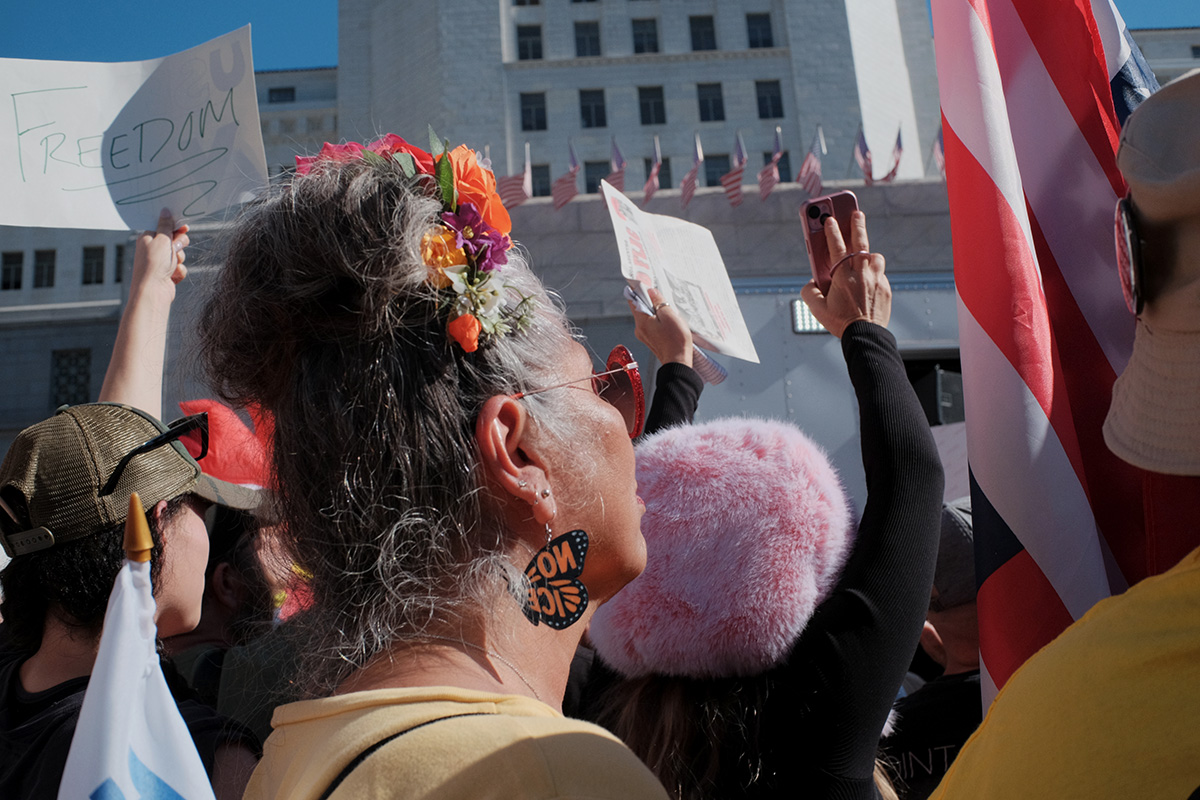
On Oct. 18th, a mosaic of Angelinos across generations and cultural backgrounds gathered outside of city hall as they proudly lifted handmade signs decrying President Trump and the current administration. This march was one of several rallies organized just within the city, and one of thousands others organized across the nation.
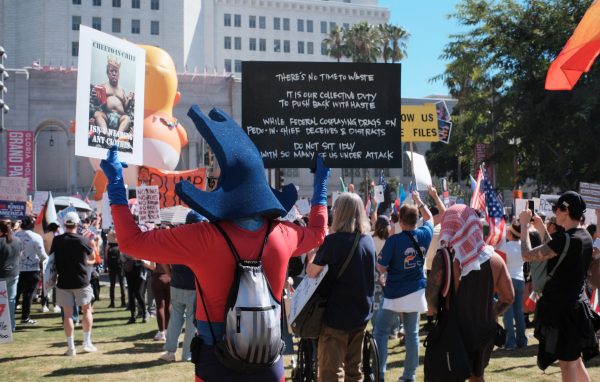
The protest was packed, with people standing nearly shoulder to shoulder as a number of local leaders including Black Women for Wellness Action Project policy analyst LaKisha Camese, TransLatin@ Coalition president Bamby Salcedo and Assemblymember Isaac Bryan, made rousing speeches and led passionate chants before the march began. Speakers like political commentator Brian Tyler Cohen did not hold back when they addressed the crowd. “[They are] so desperate to rebrand this thing as a ‘Hate America’ rally. But do you know what hating America looks like?,” asked Cohen.
Image captures by Blade reporter Kristie Song
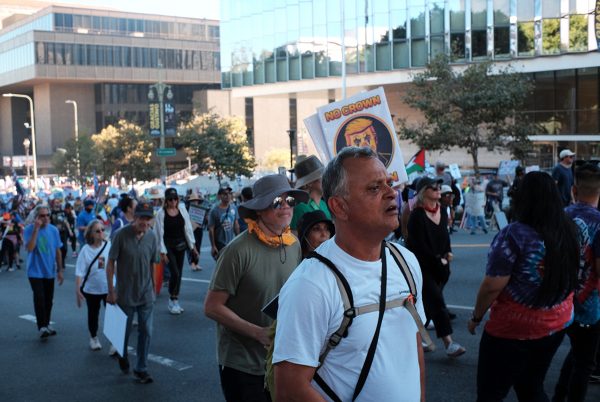
“It looks like sending secret police accountable to no one into our cities…It looks like keeping the government closed because you are so hell bent on stripping away health care from 24 million Americans and trying to get their costs to double, triple or quadruple. So if you’re looking for the ‘Hate America’ rally, might I suggest the White House.”
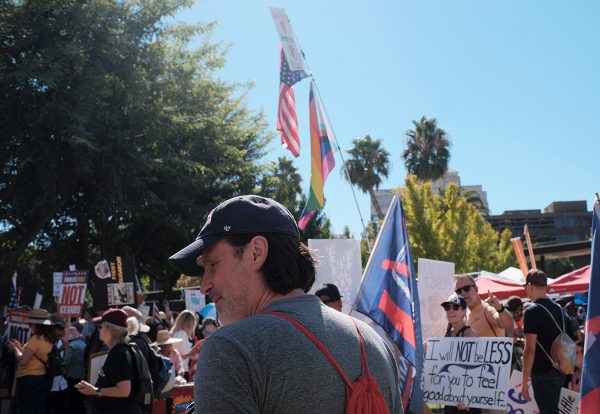
Protestors cheered at the top of their lungs with each passing speech, and each clear and explicit denouncement of the current administration. “There’s no rally like what’s happening here in Los Angeles,” said Assemblymember Bryan. “This is where Black, brown, poor, indigenous, everyday people come together…Washington D.C. doesn’t care about us, and we know that. But, we care about each other, don’t we? We believe that health care is a human right, don’t we? We believe that housing is a human right, don’t we? We will stand up to authoritarianism, won’t we? Because when we fight together, what happens? We win!”

As people began to grow restless, the march finally began, taking them to a highway overpass.
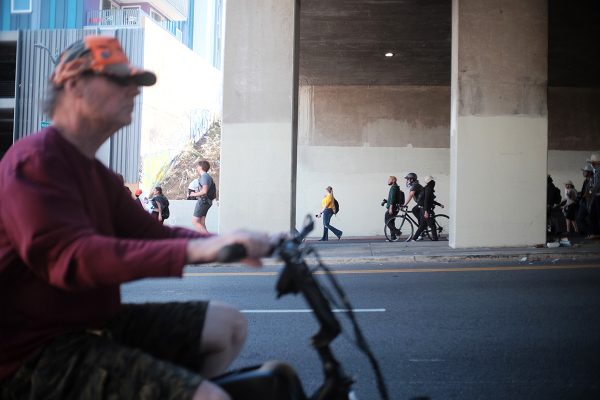
As residents boarded a bus at Cesar E. Chavez and Broadway, they were halted by blocked roads as large congregations marched by. Transit riders looked on into the crowds, their faces mere inches from some of the passing protestors. Separated by a layer of window glass, one nodded along as protestors lifted their signs above their heads and chanted “ICE out of LA!” Some waved to people inside the stalled bus, inviting solidarity from those who weren’t marching alongside them.
When the road cleared, their calls could still be heard for a little longer.
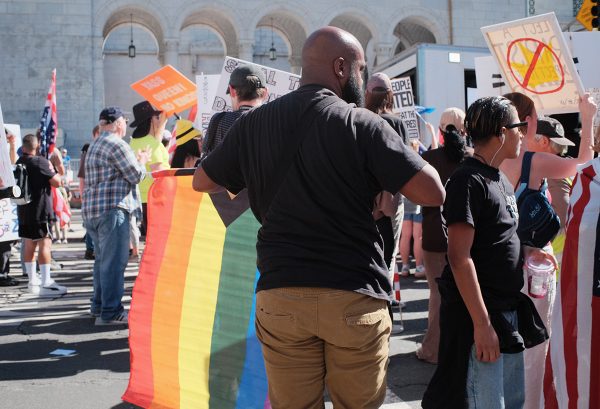
Los Angeles
L.A. County Supervisors vote to declare local emergency in support of immigrant community members
What does this declaration mean, and what’s next?
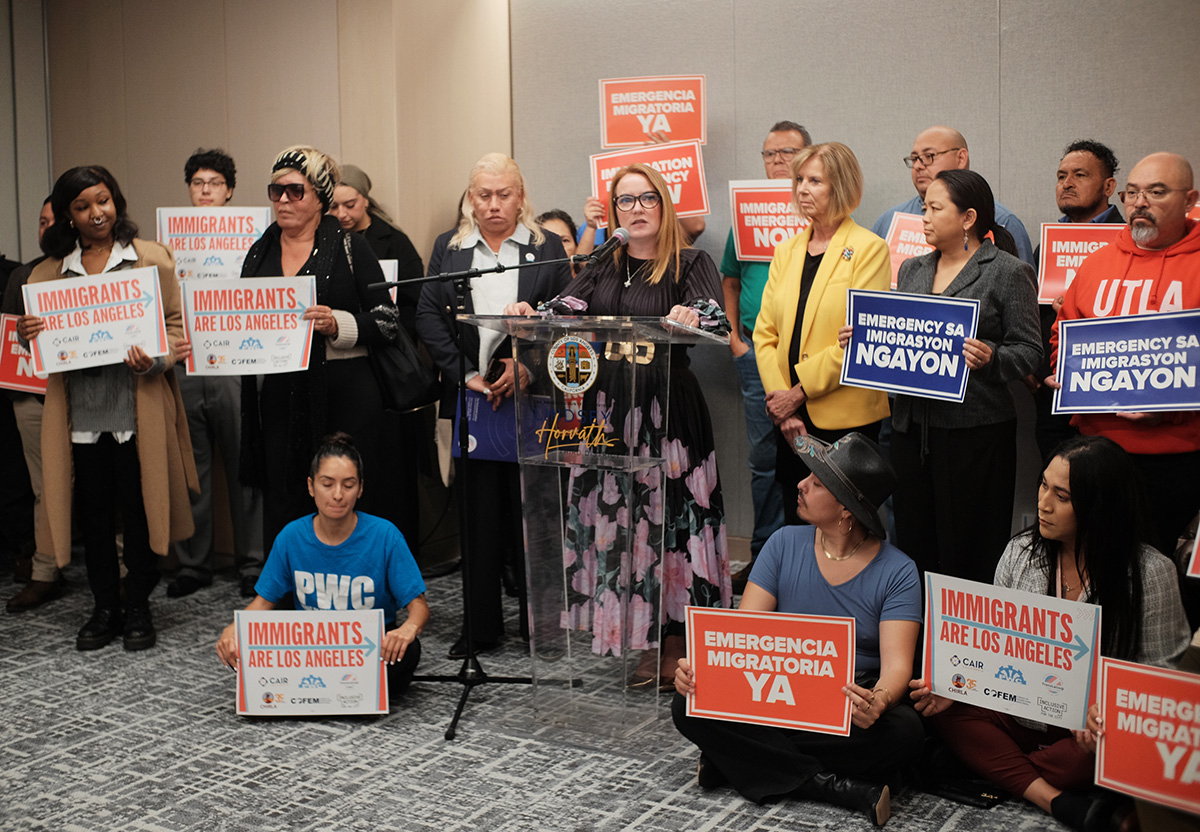
On Tuesday morning, a downpour loomed heavy over the Kenneth Hahn Hall of Administration as leaders and supporters from grassroots coalitions like Immigrants are LA and the TransLatin@ Coalition gathered inside Room 140C. They were present for a press conference with County Supervisors Lindsey P. Horvath and Janice Hahn, who together co-authored a motion to proclaim a local emergency in Los Angeles County in regards to the federal government’s actions targeting immigrant communities.
The press conference offered a moment of solidarity before the Board of Supervisors meeting happening immediately after, where the motion would be voted upon. “One of the grounds for declaring this emergency is that we can’t do it alone, and we know that county government cannot protect our residents alone,” Horvath told the Blade. “We need our cities to join with us. We need the state to join with us. That’s why declaring the state of emergency is so critical. That way, they know this isn’t business as usual. We need help.”
In the last four months, immigration operations and raids have become widespread in Los Angeles and throughout the country. In January, President Trump declared a national emergency targeting a “catastrophic immigration crisis” before issuing a proclamation “restricting the entry of foreign nationals” on the basis of national security in June. Three months later, the Supreme Court voted to pause restraining orders that would have limited immigration operations that, as advocates argued, violated civil rights.
In response to this, Supervisors Horvath and Hahn deemed it necessary to move forward with a proclamation of their own. But what does codifying and declaring a local emergency do?
“Clearing a local emergency allows the county to promulgate orders and regulations to provide for the protection of life and property,” explained Senior Assistant County Counsel Thomas J. Faughnan at the Board of Supervisors meeting. “It allows the county to request assistance from the state. It permits mutual aid to any affected area. It provides the county with certain legal immunities for emergency actions taken, and it permits the county to obtain vital supplies and equipment needed for the protection of life and property and the ability to require emergency services of county personnel.”
Supervisor Horvath also stressed that the declaration would allow local officials to accelerate various processes in locating and delivering support services to immigrant community members. “This is about action and speed. It means Los Angeles County can move faster. We can coordinate better. We can use every tool available to support and stabilize our communities,” Horvath said at the press conference. “Today, we declare an emergency — not from a place of panic, but from a place of purpose.”
It would be several hours before the proclamation was addressed at the board meeting. Still, over 10 people were waiting to be patched through on the phone so they could voice their opinions. Over 10 more people waited in person, and 79 others submitted their public comments online.
Many residents who spoke voiced their support for the declaration, echoing the importance of providing protections to their immigrant neighbors. There were also a few individuals who expressed opposition and hesitation about the potential consequences of relief efforts. One person, who only identified themself as “Doreen,” opposed potential eviction relief that could follow the declaration’s passing. “I disagree with the consideration of an eviction moratorium for those who are vulnerable. I truly believe the Board of Supervisors is operating on emotions and retaliation,” said Doreen. “So you mean to tell me that you would like to bend the law to conform to those who are here illegally?”
Amongst the five supervisors, there was general support for the declaration — but also some apprehension about what would come from it. “We see citizens and municipalities taking real, meaningful, tangible action against these federal agents being in their communities,” said Supervisor Holly J. Mitchell. “Is there anything in this declaration that would empower us to take similar action?”
While these actions can only become clearer with the passing of the declaration, other matters were clarified through this discussion. For one, the declaration will not lead to requests to the federal government for mutual aid. Additionally, the Constitution’s Supremacy Clause — which states that, if conflicting with one another, federal laws take precedence over state laws — will not hold up in the instance of illegal actions committed by federal agents during their immigration operations.
After deliberation, the motion was passed, with the only “no” vote coming from Supervisor Kathryn Barger. This declaration of local emergency remains in effect until terminated by the Board of Supervisors, and a press release from Supervisor Horvath’s office states that county departments will be able to take “necessary emergency actions to protect and stabilize” impacted communities.
The Blade will follow up with further stories as these emergency actions are developed and rolled out.
-
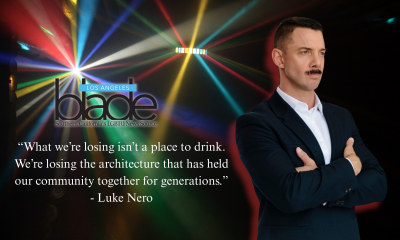
 Commentary3 days ago
Commentary3 days agoThe perfect storm: Our queer infrastructure is in crisis
-
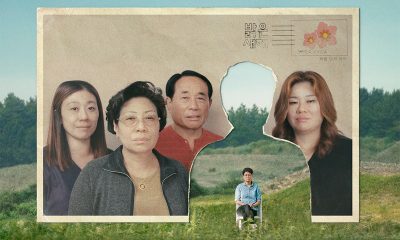
 a&e features5 days ago
a&e features5 days ago“I should have been there”: A queer Korean adoptee finds healing with original family members
-
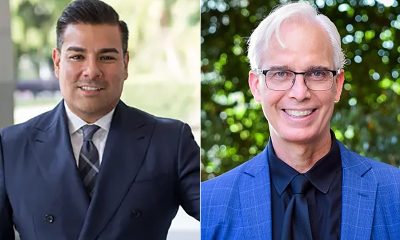
 California5 days ago
California5 days agoRicardo Lara, John Heilman inducted into Victory Institute’s Hall of Fame
-

 Television3 days ago
Television3 days ago‘Heated Rivalry’ is the gay hockey romance you didn’t know you needed
-
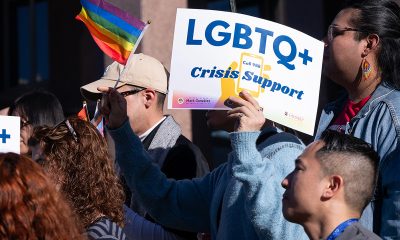
 LGBTQ+ Youth Mental Health3 days ago
LGBTQ+ Youth Mental Health3 days agoL.A. County officials advocate to reinstate “Press 3” crisis hotline for young queer people
-
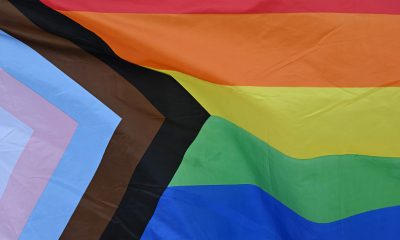
 Los Angeles1 day ago
Los Angeles1 day agoRecent L.A. County report reveals record number of hate crimes against transgender and nonbinary community members
-

 Commentary2 days ago
Commentary2 days agoLove in the time of porn: a glimpse into the dating life of an adult performer
-

 Music & Concerts2 days ago
Music & Concerts2 days agoSalina EsTitties and GMCLA are primed and ready for this weekend’s ‘Holiday Legends’
-

 Books9 hours ago
Books9 hours agoThe best books to give this holiday season
-
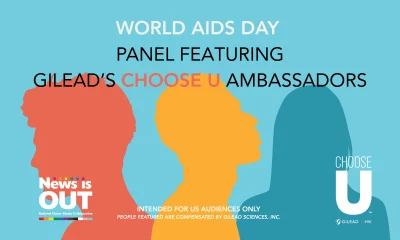
 Health16 hours ago
Health16 hours agoChoose U ambassadors share lived experiences with HIV, personal reflections, and insights
